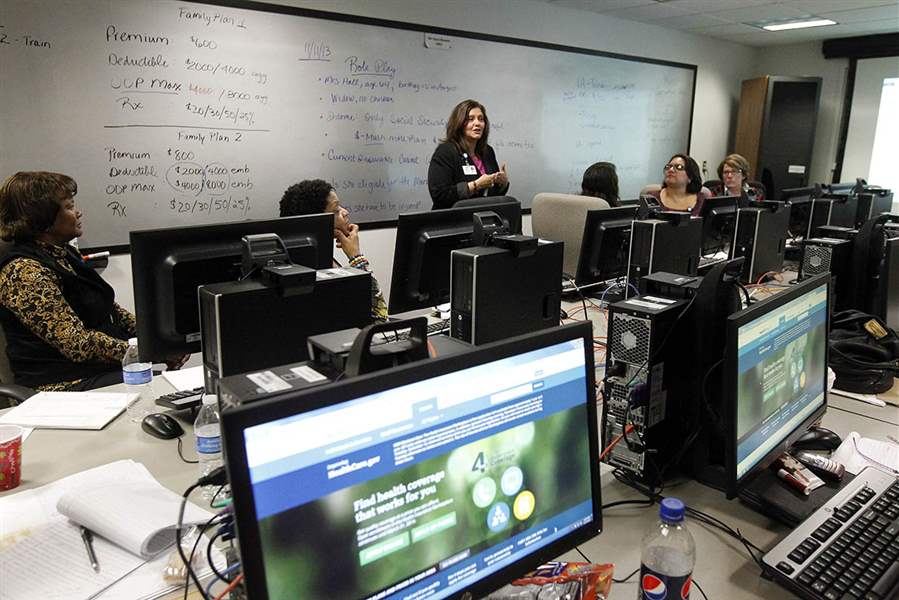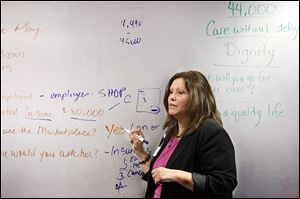
Agencies miss Nov. 1 deadline in health-care outreach plan
‘Navigators’ not yet helping local residents enroll
11/11/2013
Anna Gartner, training co-ordinator, conducts a training session for employees of Neighborhood Health Association to be a h ealth-care navigator.
THE BLADE/AMY E. VOIGT
Buy This Image

Anna Gartner conducts training for employees of Neighborhood Health Association. The association has not sent the 16 navigators into the field yet.
Two local nonprofit agencies pledged to have health-care “navigators” helping northwest Ohio residents enroll in health-care plans by Nov. 1, but almost two weeks after that deadline, there are still no navigators working in the area.
Affordable Care Act Marketplace Enrollment
■ Marketplace Web site: healthcare.gov
■ Marketplace hot line: 1-800-318-2596
■ CareNet navigator assistance: Ohioforhealth.org or 1-800-648-1176
■ Neighborhood Health Association navigator assistance or outreach: 419-214-0043
The Neighborhood Health Association and CareNet both received thousands of dollars in grant money from the department of Health and Human Services to train health-care navigators and outreach workers to help people understand the Affordable Care Act Marketplace. Neither agency, however, is ready to put boots on the ground, but for very different reasons.
“That was the plan, to get everyone ready by Nov. 1,” said Julie Grasson, the Affordable Care Act project director at CareNet. “But we just hired our fifth and final navigator at the end of last week.”
CareNet is one of 12 nonprofit agencies in Ohio chosen by the Ohio Association of Food Banks to help implement a $1.6 million grant it received for the training, said Lisa Hamler-Fugitt, executive director of the food bank. CareNet was awarded more than $250,000 from that grant.
The release of federal money to the food bank association was delayed. And as a subcontractor, a few hurdles had to be overcome, Ms. Grasson said. With a 23-county service area to cover, the goal was to find individuals who could work in those regions. That has proved difficult, she said.
“We are also still actively seeking host sites in all 22 counties outside of Lucas for our navigators to set up shop,” she said.
Those six part-time “navigators” will be stretched thinly trying to provide assistance to people over such a large area, she said.
“It averages out to one part-time navigator to every 10,000 uninsured residents,” Ms. Grasson said. So the agency plans to partner with the Neighborhood Health Association to cover counties with which they overlap: Lucas, Williams, Fulton, Defiance, Henry, and Wood areas.
The Neighborhood Health Association has hired 16 navigators to work throughout the Toledo area, but the agency directors are not putting them into the field even though they have completed the training. Right now, the agency has no official date as to when the navigators will begin to to help enroll uninsured residents in the federal health-care plans, said Brad Clark, navigator project director.
“We have strategically decided that we are going to wait until the Web site gets better. We are not going to put people out in the community right now because it just fosters more bad feelings,” Mr. Clark said.

Anna Gartner, training co-ordinator, conducts a training session for employees of Neighborhood Health Association to be a h ealth-care navigator.
“Ideally, I would like to be out before Thanksgiving,“ Mr. Clark said. The amount of funding the Neighborhood Health Association received was not provided.
Phyllis Edwards, regional lead and certified navigator for Bridging Communities Inc. in Detroit, disagrees with the wait-and-see strategy being used in Toledo.
“No, you can’t just wait,” Ms. Edwards said. “You can be proactive or reactive, and I choose to be proactive. You can’t do everything, but you can do something.”
Ms. Edwards said she has enrolled about 40 people in health-care plans by using the Web site or the marketplace’s toll-free phone line. If she runs into a problem on the site, she explains to the consumer that they are still working out the glitches and then completes the enrollment using a paper application.
Mr. Clark said the Toledo agency chose not to use the paper enrollment forms because they would be sent to a center in Kentucky. There someone would have to enter the information into the healthcare.gov Web site. He suspects there is a huge backlog of paper applications at that center.
“It will appease people. We’ll give them a paper application and say here you go. Your insurance is good. Well, the people in Lexington don’t log into a separate system than we do. They are going to have the same problems that we are having,” Mr. Clark said.
Ms. Edwards said she has had great success with the paper applications for her clients in Detroit.
“It's not true,” she said, referring to the claim that the Kentucky center will be slow in processing the paper applications. “The people that I have signed up with the paper are getting responses in two weeks,” she said.
Those who sign up by Dec. 15 can have coverage begin Jan. 1. The individual mandate that requires people to carry health insurance kicks in April 1. After that, the uninsured will face an annual penalty of $95 or 1 percent of their taxable income, whichever is greater.
Contact Marlene Harris-Taylor at: mtaylor@theblade.com or 419-724-6091